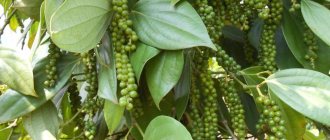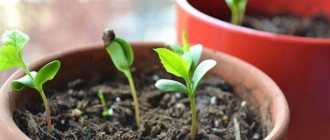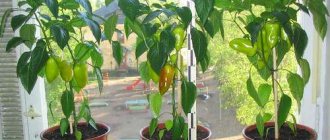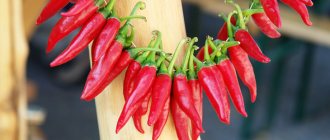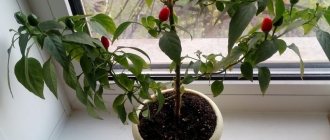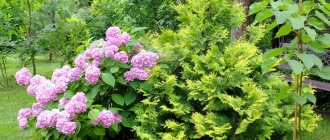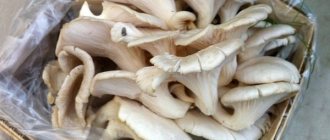Black pepper, as a spice, has been known to mankind since time immemorial.. Neither the first nor the second courses can do without its aroma and the spiciness that adds taste; delicious marinades also cannot be prepared without the well-known black peas. But not everyone knows How does this well-known spice grow? - black peppercorns. Recently, growing black pepper in a summer cottage and at home has become increasingly popular, so I would like to answer in detail all the questions that arise.
Black pepper varieties for growing at home
So, before planting, I was faced with the question of which variety to choose. I’ll say right away that I didn’t know much about peppers (especially peas), and this was a problem for me. I had to review a bunch of information and make a comparative description of the varieties. To make it easier for you, I will share the table that I came up with.
| Variety | Characteristic | pros | Minuses |
| Tellicherry pepper | Early ripening, 95-100 days before fruiting. The bushes are heavily leafy, reaching a height of up to 0.8 m. The peas are large, with a pronounced aroma. | Fruits abundantly, the grains are formed large and in large quantities. It can bear fruit several times a year. Resistant to fungal diseases, adapts well to changes in weather conditions. | Due to the dense foliage, it has to be trimmed regularly to get enough light. A garter is required, as heavy brushes with grains can be broken by branches. It's hard to find the variety in stores, I had to order it online. |
| Malabar | Also an early ripening variety. The first harvest can be harvested 90-100 days after planting. The fruits themselves have a slightly elongated shape. The color is not quite black, more like dark cherry. About 50 grains ripen on the clusters. | High yield - you can harvest up to 3 kg of pepper from one bush. Tolerates changes in temperature and climate well, and is not afraid of frost. Good immunity to diseases. | With improper care, productivity decreases. The grains are prone to shedding. To increase the number of ovaries, artificial pollination is required. |
| Vietnamese black pepper | Mid-season. The first fruits appear 120 days after planting. The bush is spreading and voluminous. Grows up to 1 meter. The clusters are large, up to 70 grains ripen on one. | Fruits well. From one bush you can collect up to 3 kg. Planting material can be found in any store, and germination is good. Flowering is abundant, ovary occurs even under unfavorable conditions. | Relatively small grains. A garter to the support is required. Needs regular fertilizing and fertilizers. |
| Betel | Hybrid variety. The bushes are spreading, with abundant foliage. Height up to 0.7 m. Small peas. Ripening occurs 95-100 days from the moment the sprouts appear. | Blooms profusely and produces a large amount of ovary. Peppers have an excellent spicy aroma and taste. Good immunity to diseases and pests. Not afraid of cold weather and changes in climatic conditions. You can dry it and make a seasoning for the winter. | Small grains. Although there are many flowers and ovaries, the yield is low for such a bush. It does not store well (mold often appears), so it is recommended to use it immediately. |
| Sarawak | Relatively new variety. Ripens in 115-120 days after planting. The height of the bush can reach 1 m. The shape of the fruit is round. An abundant amount of grains is formed on the bunch. | The seeds are easy to find. The peppers themselves have a persistent and pleasant spicy aroma and perfectly complement both first and second courses. | The yield is average - about 0.5-1 kg per bush. The fruits are small in size. Low immunity to fungal diseases. Prevention must be carried out regularly. |
| Ceylon | Hybrid variety. Belongs to the early ones. A bountiful harvest can be harvested 100-110 days after sowing the seeds. The height of the bush does not exceed 0.8 m. The weight of one brush with grains is about 90 g. The shape is slightly elongated. | High immunity to diseases. Stores well and withstands long-term transportation. The taste and aroma are rich. The grains do not crack. | Small fruits, yield up to 1 kg per bush. High maintenance requirements. |
| Lampong | A late variety of pepper, it bears fruit 130-140 days after planting. The bush itself can grow up to 1.5. The fruits have a round shape, the weight of the brush is up to 140 g. | Fruiting is long lasting. Well kept. | The smell characteristic of pepper is almost completely absent. Regular gartering and pruning are required, otherwise the branches will break under the weight and curl heavily. |
Have you learned about pepper varieties? It's time to learn how to store zucchini at home. I recently wrote about this.
This is what black pepper looks like at the ripening stage
What other types of peppers are there, watch the video:
Description of the appearance of the vine
The tree-like liana grows in the lower layer of the tropical forest and uses the trunks of more powerful trees as supports. In the wild it can grow up to 15 meters in length. The leaves are oval in shape with a pointed tip, 8-10 cm long. Their location on the branch is alternate (one after another). The flowers are collected in inflorescences on elongated racemes (8-14 cm), and are white and yellowish-gray. Drupe fruits ripen at different times, so the harvest stretches over a long period. One brush collects about 20-30 peas.
Since peppercorns grow on a climbing plant, poles (up to 6 m) are used on plantations when cultivating the crop. They are needed for twisting the vine stems and for more convenient harvesting of berries.
All varieties of trade names: black, green, white, pink and red peppercorns are spices obtained from a single plant. Their difference lies only in the processing methods and the nature of the ripeness of the berries.
There are several ways to grow black peppercorns at home. This is to use seeds, cuttings, and layering.
How to grow black pepper from seeds in an apartment
Once you have selected the seeds, then it’s time to start planting. There is nothing complicated here, you just need to do everything according to the rules. And I’ll definitely introduce you to them.
There is no desire to grow anything, then harvest vegetables. Read my article on how to properly freeze eggplants for the winter.
Where to get black pepper seed
I will suggest the following options:
- The garden store where you purchase your seeds. There is one minus: if the store is small, then it is unlikely to have black pepper. The same point applies to small cities. There may also not be the variety you want. In general, you will have to run around and look.
- In the Internet. You can find any variety here, but poor quality planting material may arrive.
- In nurseries. But here you can't miss. In nurseries specializing in this crop, you can definitely find the variety you need. And since they value their reputation, the planting material will always be of high quality.
- Ask a neighbor or friends for pepper. You can collect seeds from it yourself and grow bushes.
Black pepper seeds differ from others in appearance and shape.
Soil preparation
Now let's talk about the soil. Most of the time, for the peppers, I prepare them myself. For me it has the following composition:
- land (garden);
- humus;
- peat;
- wood ash;
- superphosphate.
To prepare, I mix earth, peat and humus in equal proportions. I add 0.5 liters of wood ash and 2 matchboxes of superphosphate to the general mixture. That's it, mix it and it's ready.
The composition of universal soil suitable for different types of plants can be found in the video:
Author's note
Natalia Papanova
Blog author
You can replace humus with compost. This is not important.
You can buy soil at the store. I can recommend “Fart Universal”. I liked the brand and manufacturer and have used it a couple of times. If you decide to use something else, then look at the composition. If the soil is 100% peat, then do not take it - this option is not suitable for peppers
.
And before planting, do not forget to disinfect the soil so that the bushes hurt less. To disinfect, spill the soil with a weak solution of potassium permanganate (2-5 g of the drug per bucket of water).
If you think that growing vegetables at home is difficult, then just harvest them for the winter. For example, I recently wrote about how to store potatoes in an apartment.
Only in nutritious soil will pepper produce a good harvest
What container is best to plant in?
To plant seeds, take small containers; the roots will not rot in them. I can advise the following:
- Special plastic cells. Not a bad option. When transplanting, the pepper is pulled out directly with a lump of earth, so that the root system is not injured.
- Plastic cups (small). Identical to the previous option. Only in this case everything is a little cheaper. The peculiarity is that you will have to make drainage holes at the bottom yourself.
- Wooden boxes. The planting material is laid in a continuous pattern, so that later it is not very convenient to plant the specimens, since the root system is injured.
- Peat cups. Convenient, but expensive. But then, when the plants are planted in a permanent place, there is no need to fool your head. Stick the glass directly into the ground and you're done.
When transplanting to a permanent place, consider the volume of the pot. It must be at least 1 liter. The material can be anything. I like clay containers. They look beautiful and absorb excess moisture well.
Author's note
Natalia Papanova
Blog author
Before planting, disinfect all containers. To do this, simply pour boiling water over them and dry.
If you don’t want to grow the black variety, then read how to grow other varieties of pepper at home.
Growing black pepper at home?
Not really
Growing seedlings
You need to select the largest seeds from the bag and soak them in warm water for a day.
The ones that pop up can be immediately rejected, they are empty. Treat those that have fallen to the bottom with any growth stimulant - “Bud”, “Ovary”. You can do it differently and add 1 tbsp to a glass of water. a spoonful of aloe juice. Related article:
Sweet pepper Orange miracle
The swollen seeds are laid out between two layers of gauze in a container with damp sand and covered with film. The sand must be constantly wet and warm, so the containers are placed near the battery and regularly sprayed with water. Do not forget to periodically remove the film for ventilation.
After the peas hatch, they are placed in cups - 1 piece each. in each, so as not to injure the seedlings when picking. The optimal soil value ranges from 5.5-6.5. When independently compiling an earthen mixture, take turf and leaf soil, humus, peat and sand. Be sure to ensure high drainage.
The plant requires stable warm temperatures. High air humidity is also required. Therefore, before germination, it needs to be equipped with an insulated greenhouse. The simplest option is to place the cups on a wire rack placed above a pan of water and cover them with foil on top.
Related article:
Sweet pepper Atlant F1: description and reviews
After the appearance of the second leaf, the seedlings are fed with a solution of bird droppings (1 to 10). Subsequently, fertilizing is carried out once every couple of weeks with a mineral complex for decorative deciduous crops.
Caring for Homemade Black Pepper
The bushes have grown stronger, it’s time to think about how to care for the plant now. Here I will also come to your aid to make it easier. There is nothing complicated here: you just need to take a couple of points into account.
Lighting, temperature and humidity
Pepper loves light, so south-facing windows are suitable for growing. Western and eastern, in principle, are also suitable, but northern ones are taboo. The daylight hours for peppers should be 12 hours. So, if there is not enough, organize additional lamps for lighting.
The required temperature is 25 degrees. Do not allow the temperature to drop below 15 degrees - all growth processes will slow down. And if the indicator drops another 2-3 degrees, then the plant will completely stop growth and development.
There are no special instructions regarding air humidity. In this regard, black pepper is not picky. But for prevention, spray the plant with a spray bottle once a week.
Don't want to take care of your pepper? Then prepare your vegetables in advance. For example, read how to store potatoes on the balcony in winter.
A bush that gets enough light will have bright green foliage.
Proper watering
Peppers need to be watered 2-3 times a week. I use approximately 200-250 ml per pot. Depending on the volume of pots you planted the peppers in, this indicator may vary. So focus on the soil: if it’s dry, it’s time to water.
Feeding and fertilizer
Feeding is very important for black pepper; four of them need to be done:
- The first feeding is done when 2-3 leaves appear on the seedlings. I prepared the following solution: dilute 30 g of superphosphate in 10 liters of warm water. I let it sit for a day. Then I added 10 g of ammonium nitrate, 30 g of calcium sulfate and 10 g of urea. And then she brought it into the root part. This fertilizer accelerates the growth process at the initial stage and promotes the formation of green mass.
- The second feeding is carried out after transplanting the plant to a permanent place. I recommend using a mixture of 10 g of urea and 5 g of superphosphate, diluted in 10 liters of water. Thanks to this, the stress resulting from the transplant will quickly pass.
- Feed the third time at the time of flowering. To obtain a solution, combine 1 tsp. potassium and urea, as well as 2 tbsp. l. superphosphate. Dilute everything in 10 liters of water and apply 1 liter per bush to the root part. Thanks to this, the pepper will bloom even more actively and set better.
- The fourth feeding is carried out at the time of fruiting. Here I recommend the complex fertilizer “Aquadon-micro”. Diluted in the following proportion: 50-70 ml per 10 liters of water. Fertilizer increases yield and improves the quality of ripening grains.
Don’t want to fool around with feeding? Then plant another crop that doesn't need as much fertilizer. For example, learn how to grow eggplants at home. You definitely won’t suffer with them for a long time!
Features of caring for black pepper in winter
In winter, care rules boil down to the following points:
- Reduce the frequency of watering to 1-2 times a week. In this case, there is no need to spray the bush with a spray bottle.
- Place the pot away from heating devices (radiators and pipes).
- Organize additional lighting in the morning and evening for 2-3 hours.
- If the pepper is on a windowsill, under which there is a radiator or pipe, place thick foam plastic under the pot. This will protect the root system from overheating.
To learn how to organize additional lighting for plants, see the video below:
We learned how to care for black pepper in winter, then it’s time to get acquainted with the proper storage of carrots at home so that they do not spoil.
Is it possible to grow the plant at home?
Black pepper can only grow in regions with a warm climate and inevitably dies when the air temperature drops below +10°C, so it will not be possible to grow it in open ground along with other crops at your summer cottage.
At home, this spice can only be grown in a warm room, taking proper care of the plant. The process of growing black pepper itself is not difficult, but requires the creation of a certain microclimate in the room. If you provide the vine with comfortable conditions for growth, then over time it can reach a height of 2 m.
How to replant black pepper in a room
Pepper transplantation occurs as follows:
- Prepare a new pot and soil (disinfect).
- Remove the indoor pepper from the old container directly with a lump of earth. Place carefully in a new location so as not to damage the root system. Add the missing amount of soil.
- Compact a little by pressing down with your hand. Add water.
That's it, the transplant process is complete.
Author's note
Natalia Papanova
Blog author
Do not water the bush for 3-4 days before transplanting. Then it will be easier for you to pull out the root system along with the entire lump of earth.
It is better not to shake off the soil from the roots, this will allow the plant to take root faster.
FAQ
Natalia Papanova
Blog author
Ask your question
Now let's talk about the questions that arise when growing black pepper. So that they don’t take you by surprise, I’ll share the answers.
What is the best way to grow black pepper at home?
Everything here, as they say, depends on taste and color. There is no definite answer: some are comfortable in plastic cells, while others are comfortable in peat pots. The final result depends little on this. So look at your desires and capabilities.
Benefit for health
Habitually shaking a pepper shaker over a plate to give the dish a little heat, we rarely think about what valuable product we are holding in our hands. And it’s worth starting with the fact that the hot substance in pepper (piperine) significantly increases the body’s ability to absorb vitamins and minerals from the food received. But that’s not all: black pepper contains three times more vitamin C than oranges, it is rich in B vitamins, carotene, calcium, iron phosphorus, and esters.
Black pepper has a beneficial effect on three systems: digestive, respiratory and circulatory. Research shows that pepper thins the blood and destroys clots, therefore reducing the risk of developing pathologies of the heart and blood vessels.
Related article:
Fertilizers for pepper: means, rates and application features
The spice improves appetite and helps normalize digestion. In addition, it kills bacteria, relieving a person from colic, constipation and diarrhea. Pepper destroys fat, but this is not enough to say. Due to the systematic use of seasoning, body temperature rises, as a result of which metabolism accelerates and, accordingly, fat cells are burned more actively. Scientists from the University of California have proven that in order to lose weight, you need to eat 2 g of ground pepper per day. Even if a person overeats, he will not form new fat tissue.
The Mayan Indians used black pepper to relieve pain, treat asthma, cough and sore throat. In addition, the spice enhances the healing properties of other herbs.
Summarize
- It is mandatory for black pepper to be fed 4 times. Other fertilizers are applied as needed.
- Do not feed shrubs with both organic and inorganic fertilizers. Excess microelements will not lead to anything good.
- Water the plants with settled or spring water at room temperature. This will have a positive effect on the development of the root system.
Now, in theory, you know how to plant black pepper at home. All that remains is to put everything into practice. Don’t put off this process for later, but start planting now, before all the knowledge in your head disappears. Then you can be sure that everything will work out for you.
Typical mistakes when growing
Sometimes, when grown at home, black pepper starts to get sick, and in some cases, it dies. The reason for this is errors in plant care, which lead to disturbances in microclimate conditions and negatively affect the development of the vine.
Common ones:
- if you place black pepper in an insufficiently lit place, its stem will stretch upward and there may be no flowering;
- if fertilizers are applied untimely, the plant begins to shed its leaves and stops bearing fruit;
- as a result of insufficient watering or too low air humidity, the tips of black pepper leaves turn yellow and dry out;
- if there is an excess amount of moisture, the leaves of the vine turn yellow, and if the room is cool (+16...+18°C), chlorosis may occur;
- In direct sunlight, black pepper burns and dries out.
Despite the fact that black pepper is used to growing in warm tropical climates, it also takes root well in indoor conditions. To successfully grow this exotic plant in your home, which produces spicy and aromatic fruits, it is enough to follow the listed recommendations for caring for it.
Popular varieties and varieties
The most popular black pepper in the world is still Indian, especially its Tellicherry and Malabar varieties. But there are “worthy competitors” in other countries as well.
- Malabar. Homeland - Indian state of Kerala. But often any pepper produced in India is called Malabar. It stands out for its large size of black-brown fruits, their high density and pronounced aroma, easily recognizable by gourmets. Due to the high content of the alkaloid piperine, it is quite spicy.
- Tellicherry. Elite variety of Indian black pepper. Grown exclusively on plantations in the Thalassari area. It is valued for its large size (diameter more than 4.75 mm), the absence of foreign impurities and the almost complete absence of “empty” berries (the so-called light berries).
- Lampong. The variety comes from Indonesia. Mainly grown on the island of Sumatra. This variety received its name from the province where most of the plantations are located. Compared to Malabar pepper, it has smaller fruits. Their color is more likely not black, but dark gray. But the quality of Indonesian pepper is not inferior to Indian pepper.
- Sarawak. Grown in Malaysia, on the coast of Borneo. The highest quality Malaysian pepper is considered to be the one with the brown label. Then there are yellow, black, purple and gray labels.
- Chu Xie. Vietnam began growing black pepper for export quite recently. Therefore, the quality of the product is noticeably inferior, for example, to Indian. The diameter of the peas is up to 3 mm. The piperine content is low - about 4%.
- Brazilian. It appeared on the world market relatively recently, in the 60s of the last century. But since then, Brazil has become one of the main exporters of this spice. Grown mainly in the state of Pará. An interesting variety of peppercorns. Its skin is black and smooth, but the fruits themselves are very light, creamy or creamy in color.
- Chinese. The plantations are located on Hainan Island. Black pepper has been grown in China for a long time, but has been exported for a very short time. It is distinguished by a light grayish tint of the skin and a very piquant, but at the same time mild taste.
- Ceylonese. The hottest and hottest of the existing varieties of black pepper, not much inferior to chili. This is due to the increased content of the alkaloids piperine and capsaicin. Because of this, it is used quite rarely in cooking; it is used mainly as a raw material for the production of extracts.
The Malabar coast is the birthplace of black pepper, and to this day the product grown there is deservedly considered elite
About the propagation of peppercorns
This crop is propagated by:
1) cuttings,
2) layering,
3) dividing the bush.
1) In the first case, a cutting (or several) is prepared, on which there are 2-3 buds. Place the soil mixture, one part with leaf soil and two parts with sand. Cover with polyethylene to create a greenhouse effect.
The temperature should be maintained within 24°C. In 21 days, the root system will begin to develop. After which the plants should be transplanted into separate containers with a diameter of at least 9 cm.
2) Layers are shoots that, pressing against the soil (can be purposefully fixed), take root and give rise to the growth of the root system. Especially if you water them well and create good lighting conditions. Next, they are picked and transplanted into a separate pot.
3) This method only works for an adult plant.
White peppercorns: general characteristics of the plant
white pepper
It is difficult to imagine black pepper in the form of a tree-like vine growing up to 15 meters. But that's exactly how it is! In places where they are grown on a commercial scale, special poles are used to place restrictions on plant growth (up to 5 m).
Black pepper /Piper nigrum/ produces small flowers collected in elongated and flowing inflorescences, similar to spikelets. This is where the peas ripen - the future spice! The leaves of the plant are oval, green, and often have a grayish coating.
The homeland of pepper is the tropical part of our Earth - this is Southeast Asia, the countries of Sri Lanka, India, Sumatra and Borneo. The main global supplier of Piper nigrum is Sumatra.
